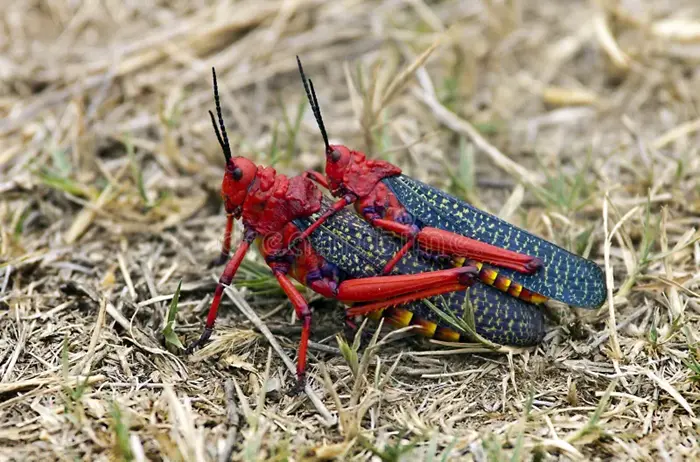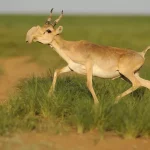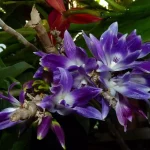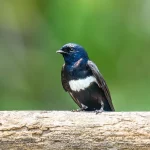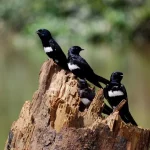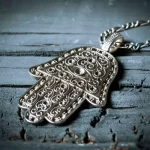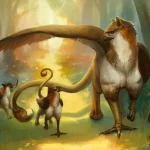Red locusts, striking in their vivid coloration and powerful presence, carry a rich tapestry of symbolic meanings across various cultures and spiritual traditions. These fascinating insects, often associated with transformation and change, have been revered and feared in equal measure throughout history. In this comprehensive exploration, we will delve into the spiritual meanings, cultural symbolism, totemic significance, dream interpretations, myths, and legends associated with red locusts. Furthermore, we will uncover how one might discern if the red locust is their spirit animal.
Red Locusts Spiritual Meaning
Red locusts are often seen as symbols of transformation and adaptability. Their life cycle, from egg to nymph to adult, embodies the concept of metamorphosis, making them potent symbols of personal growth and change. In many spiritual traditions, the red locust is viewed as a messenger, bringing insights from the spiritual realm.
In some cultures, the red color of these locusts is linked to energy, vitality, and passion. The fiery hue suggests a connection to the life force and the creative energy that drives all living beings. Thus, encountering a red locust may be interpreted as a sign to embrace one’s passions and to channel one’s energy towards meaningful pursuits.
Additionally, red locusts are sometimes seen as harbingers of both destruction and renewal. Just as locust swarms can devastate crops but also encourage new growth, the appearance of a red locust in one’s life might signify the end of one phase and the beginning of another. This duality underscores the necessity of balance and the cyclical nature of life.
Red Locusts Symbolism (In Different Countries)
The symbolism of red locusts varies significantly across different cultures:
Africa: In many African cultures, locusts are seen as both a blessing and a curse. While they can bring famine through the destruction of crops, they also represent resilience and survival. The red locust, in particular, may be viewed as a symbol of the unpredictable nature of life and the importance of adaptability.
Asia: In some Asian traditions, red locusts are considered omens of change. Their appearance might be interpreted as a sign of impending significant events, whether positive or negative. They are also seen as symbols of persistence and determination, as these insects can travel vast distances and survive in harsh conditions.
Europe: Historically, locusts have been associated with plagues and divine punishment in European folklore. However, the red locust, with its unique coloration, might also symbolize passion, war, and the intensity of human emotions.
Native American: Among some Native American tribes, the locust is a symbol of transformation and personal growth. The red locust might be seen as a particularly powerful totem, representing the fire of spiritual awakening and the courage needed to face life’s challenges.
See Also: What Does A Locust Symbolize?
Red Locusts Totem
As a totem, the red locust embodies several key traits:
Transformation
The red locust as a totem signifies profound personal transformation. Those who identify with this totem are often on a journey of self-discovery and change, constantly evolving and adapting to new circumstances.
Resilience
This totem animal teaches resilience and the ability to thrive even in the face of adversity. Just as locusts can endure harsh environments, individuals with the red locust as their totem are likely to possess inner strength and perseverance.
Energy and Passion
The red color of the locust infuses this totem with energy and passion. It encourages individuals to pursue their goals with vigor and to live life with intensity and enthusiasm.
Balance
The dual nature of the locust as both a destroyer and a catalyst for new growth highlights the importance of balance. This totem animal reminds us that endings are often necessary for new beginnings.
Red Locusts Symbolize in Dreams
Dreaming of red locusts can have various interpretations, depending on the context of the dream:
Change and Transformation
Seeing red locusts in a dream might indicate that you are undergoing or about to undergo a significant transformation. This could be related to your personal life, career, or spiritual journey.
Warning or Caution
Red locusts in dreams can sometimes serve as a warning. They might suggest that you need to be cautious about impending changes or challenges. This warning could be about preparing for difficulties or being mindful of potential disruptions in your life.
Passion and Energy
Dreaming of red locusts can also symbolize a surge of passion and energy. It might be a sign that you need to harness this energy to pursue your goals or to ignite a new project or relationship.
Balance
The presence of red locusts in dreams can serve as a reminder to find balance in your life. It might suggest the need to integrate different aspects of yourself or to balance your personal and professional life.
Myths and Legends About Red Locusts
Red locusts feature in various myths and legends across cultures:
Biblical References
Locusts are famously mentioned in the Bible, particularly in the context of the plagues of Egypt. While the biblical locusts are not specifically described as red, the association with divine intervention and punishment can extend to red locusts in some interpretations.
African Folklore
In some African legends, locusts are seen as messengers from the gods, bringing important omens. The red locust, with its striking appearance, might be viewed as a particularly significant messenger, heralding major events or changes.
Asian Mythology
In certain Asian myths, locusts are associated with warriors and battles. The red locust, with its bold coloration, might be seen as a symbol of courage and martial prowess.
Native American Legends
Among some Native American tribes, locusts are seen as teachers of adaptability and transformation. Stories often depict them as guides through difficult times, helping individuals to navigate personal challenges and emerge stronger.
How Do You Know if the Red Locusts is Your Spirit Animal
Determining if the red locust is your spirit animal involves introspection and awareness of your experiences and feelings:
Repeated Encounters: If you frequently encounter red locusts in your daily life, dreams, or meditations, this could be a sign that the red locust is your spirit animal. Pay attention to the circumstances of these encounters and any messages they might convey.
Personal Resonance: Reflect on your personal traits and life experiences. Do you feel a strong connection to the themes of transformation, resilience, and passion? If the characteristics of the red locust resonate deeply with you, it might be your spirit animal.
Guidance and Messages: Consider the guidance and messages you receive from your encounters with red locusts. Do they provide insight or clarity about your life’s path? If these interactions offer valuable wisdom or support, the red locust might be your spirit animal.
Spiritual Practices: Engage in spiritual practices such as meditation, prayer, or journeying to seek confirmation. Ask your higher self or spiritual guides to reveal your spirit animal. If the red locust consistently appears in your visions or meditations, it is likely your spirit animal.
Conclusion
The red locust, with its vivid color and dynamic presence, is a powerful symbol of transformation, resilience, and passion. Across various cultures and spiritual traditions, it carries rich and diverse meanings, from omens of change to symbols of personal growth. Whether encountered in dreams, myths, or daily life, the red locust offers profound insights and guidance. By understanding the spiritual significance, cultural symbolism, and totemic attributes of the red locust, we can appreciate the deeper messages this remarkable insect brings to our lives. Whether as a spirit animal, a totem, or a symbolic messenger, the red locust encourages us to embrace change, harness our inner strength, and pursue our passions with vigor.
Related topics:

